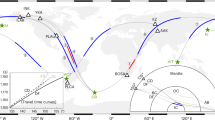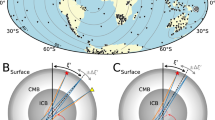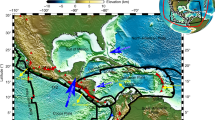Abstract
IN 1983, Poupinet et al.1 observed that compressional seismic waves traversing the inner core along a trajectory parallel to the Earth's rotation axis arrive faster than the same (PKIKP) waves travelling in the equatorial plane. They interpreted this observation as revealing prolate topography of the inner-core boundary. In 1986, Morelli et al.2 and Woodhouse et al.3 suggested that inner-core anisotropy could explain both the travel-time observations and the anomalous splitting of some of the Earth's normal modes. Inner-core anisotropy continues to be the preferred explanation for the travel-time anomalies, although there is disagreement about the magnitude of anisotropy4–6. More recent explanations for the anomalous splitting involve topography of the inner-core and core–mantle boundaries as well as lateral heterogeneity of the core7–11. In particular, Widmer et al.11 dismissed a rather complex recent model of inner-core anisotropy12 because it could not explain the splitting of several previously unidentified modes. Here I show that the anomalous splitting of all currently identified modes can in fact be explained by cylindrical anisotropy of the Earth's inner core that is also compatible with the observed PKIKP travel-time anomalies. The resulting model should be regarded as an upper limit to the amount of anisotropy, as lateral heterogeneity also undoubtedly contributes to the splitting.
This is a preview of subscription content, access via your institution
Access options
Subscribe to this journal
Receive 51 print issues and online access
$199.00 per year
only $3.90 per issue
Buy this article
- Purchase on Springer Link
- Instant access to full article PDF
Prices may be subject to local taxes which are calculated during checkout
Similar content being viewed by others
References
Poupinet, G., Pillet, R. & Souriau, A. Nature 305, 204–206 (1983).
Morelli, A., Dziewonski, A. M. & Woodhouse, J. H. Geophys. Res. Lett. 13, 1545–1548 (1986).
Woodhouse, J. H., Giardini, D. & Li, X.-D. Geophys. Res. Lett. 13, 1549–1552 (1986).
Shearer, P. M. & Toy, K. M. & Orcutt, J. A. Nature 333, 228–232 (1988).
Shearer, P. M. & Toy, K. M. J. geophys. Res. 96, 2233–2247 (1991).
Creager, K. C. Nature 356, 309–314 (1992).
Ritzwoller, M., Masters, G. & Gilbert, F. J. geophys. Res. 91, 10203–10228 (1986).
Giardini, D., Li, X.-D. & Woodhouse, J. H. Nature 325, 405–411 (1987).
Ritzwoller, M., Masters, G. & Gilbert, F. J. geophys. Res. 93, 6369–6396 (1988).
Giardini, D., Li, X.-D. & Woodhouse, J. H. J. geophys. Res. 93, 13716–13742 (1988).
Widmer, R., Masters, G. & Gilbert, F. Geophys. J. Int. 111, 559–576 (1992).
Li, X.-D., Giardini, D. & Woodhouse, J. H. J. geophys. Res. 96, 551–557 (1991).
Dziewonski, A. M. & Anderson, D. L. Phys. Earth planet. Inter. 25, 297–356 (1981).
Woodhouse, J. H. & Dahlen, F. A. Geophys. J. R. astr. Soc. 53, 335–354 (1978).
Masters, G. & Gilbert, F. Geophys. Res. Lett. 8, 569–571 (1981).
Stevenson, D. Geophys. J. R. astr. Soc. 88, 311–319 (1987).
Love, A. E. H. A Treatise on the Mathematical Theory of Elasticity 4th edn (Cambridge Univ. Press, 1927).
Michelini, A. & McEvilly, T. V. Bull. seism. Soc. Am. 81, 524–552 (1991).
Brown, J. M. & McQueen, R. G. J. geophys. Res. 91, 7485–7494 (1986).
Anderson, O. L. Geophys. J. R. astr. Soc. 84, 561–579 (1986).
Press, W. H., Flannery, B. P., Teukolsky, S. A. & Vetterling, W. T. Numerical Recipes in C (Cambridge Univ. Press, 1988).
Author information
Authors and Affiliations
Rights and permissions
About this article
Cite this article
Tromp, J. Support for anisotropy of the Earth's inner core from free oscillations. Nature 366, 678–681 (1993). https://doi.org/10.1038/366678a0
Received:
Accepted:
Issue Date:
DOI: https://doi.org/10.1038/366678a0
This article is cited by
-
Superionic effect and anisotropic texture in Earth’s inner core driven by geomagnetic field
Nature Communications (2023)
-
Observations of the Singlets of Higher-Degree Modes Based on the OSE
Journal of Earth Science (2018)
-
Equatorial anisotropy in the inner part of Earth’s inner core from autocorrelation of earthquake coda
Nature Geoscience (2015)
-
Existence of finite rigidity layer at the base of the Earth’s liquid outer core inferred from anomalous splitting of normal modes
Earth, Planets and Space (2014)
-
Earth’s solid inner core: Seismic implications of freezing and melting
Journal of Earth Science (2013)
Comments
By submitting a comment you agree to abide by our Terms and Community Guidelines. If you find something abusive or that does not comply with our terms or guidelines please flag it as inappropriate.



